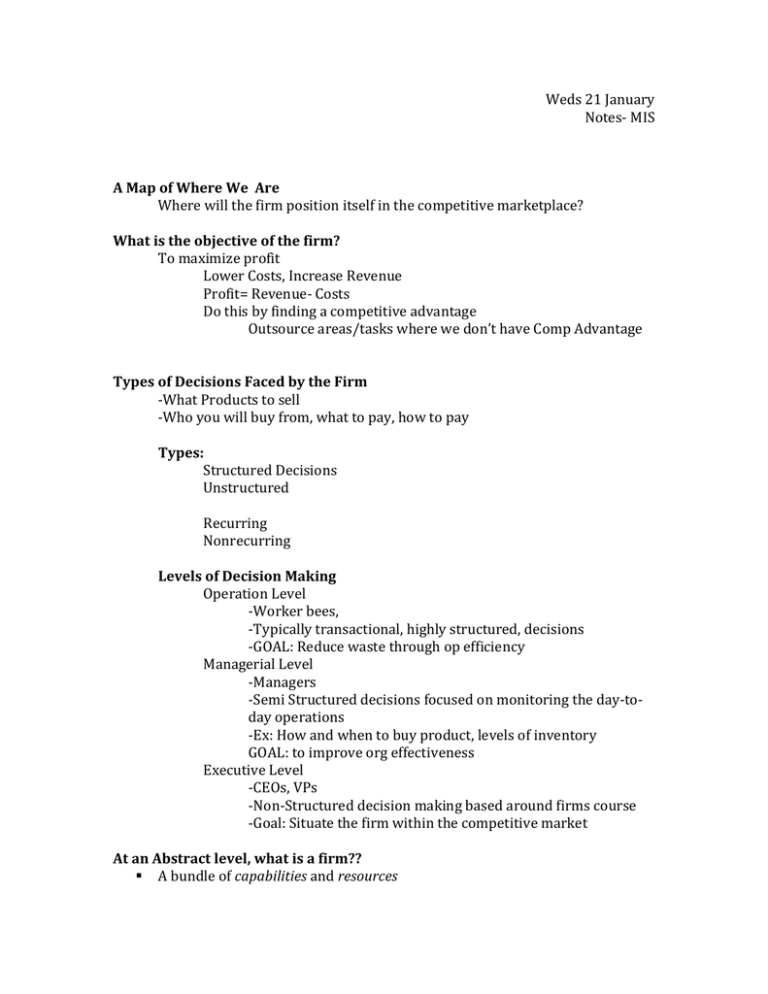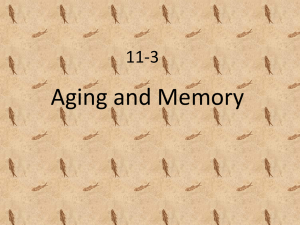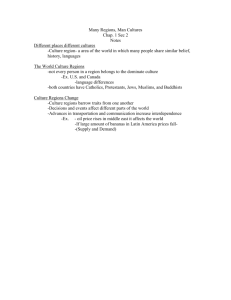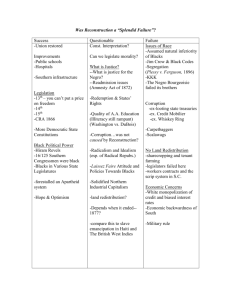Week 2 – Notes - Temple Fox MIS
advertisement

Weds 21 January Notes- MIS A Map of Where We Are Where will the firm position itself in the competitive marketplace? What is the objective of the firm? To maximize profit Lower Costs, Increase Revenue Profit= Revenue- Costs Do this by finding a competitive advantage Outsource areas/tasks where we don’t have Comp Advantage Types of Decisions Faced by the Firm -What Products to sell -Who you will buy from, what to pay, how to pay Types: Structured Decisions Unstructured Recurring Nonrecurring Levels of Decision Making Operation Level -Worker bees, -Typically transactional, highly structured, decisions -GOAL: Reduce waste through op efficiency Managerial Level -Managers -Semi Structured decisions focused on monitoring the day-today operations -Ex: How and when to buy product, levels of inventory GOAL: to improve org effectiveness Executive Level -CEOs, VPs -Non-Structured decision making based around firms course -Goal: Situate the firm within the competitive market At an Abstract level, what is a firm?? A bundle of capabilities and resources People that can do things, and the stuff that allows firm to make product/service The implementation of these capabilities and resources are what allows the firm to function Executives are responsible for enacting their strategy using these capabilities and resources -Parts Accounting Marketing Operations Supply Chain Sales Human Resources -Information Technology is the thing that facilitates communications between all of these different parts -Spreading info across firm allows efficiency Business Value Added What does this mean? o $--> FIRM $$ (Output from firm is greater than input) o Value added comes from a firms resources and capabilities How can we do this at each level? o Operational Level- Automate Example: Automated call centers to speed up customer service o Managerial- Learn o Executive- Strategize IS for Organizational Learning Information Systems is very good at tracking and identifying trends -Example: Homes not often bought during winter, more often in Summer -So on Managerial level, loan officers/managers can plan staffing, training based around this IS for Supporting Strategy: Doing things Smarter What is the implication of Info systems? How to use in organization? -Carr -IS should be implemented that support that strategy -Low Cost strategy implies information systems to minimize expenses Defender/Reactor -High quality strategy implies IS to support ensuring excellent quality and minimal defects How to think about what strategy my firm should use? -Should take into consideration of the competitive environment as a whole, as well as future potential options Porter’s Five Forces (Five Forces Model) Buyer Power -Amount of leverage the customer has -Reduce Prices, Increases Quality, Increases Value add Threat of New Entrants -Barriers to entry= Is it hard or easy to get into the market? -Low Barrier to entry = Reduced Prices, Lost Market Share Supplier Power -Bargaining power of suppliers -If supplier has more Power = Increases Costs, Reduced Quality Threat of substitutes of services -Increased Threat = Product returns, Lower market share, lost customers Rivalry Among Existing Customers Sources of Competitive Advantage Quality Ex: Toyota Service Ex: IBM Low Cost Ex: Wal-Mart Proprietary Ex: Coca Cola Innovation Ex: Apple Brand Ex: Porsche Value Ex: Nintendo Each Successful firm has its own source of competitive advantage Can be born of, or assisted by, Info Technology Ultimately we achieve this by aligning all aspects of the firm so that they are pushing in the exact same direction. Eample: KIA; If they came out with a HIGH Quality strategy, it would be mismatched, and would create problems for the firm Pursuit of Competitive Advantage What Technology enables an organization to achieve this? Best Made Product Robots eliminate defects. Databases give more info on customers. Track info about products Superior Customer Sources Advent of Digital age has facilitated outsourcing and globalization Why? The reduction in communication costs and spread of the capitalistic ideal results in the manager being able to divest strategically to align the firm around its core competency International Business Strategies in International IS Strategies 1) Home Replication A Locally focused strategy where the firm merely exports products to garner additional sales o Think Manufacturing Porsche is the Valacich Example. They make Porsche for German Autobahn, and export to world. Prof thinks this is a weak example. Jims Steaks is better example. Strengths: no heterogeneity in the core competency, do same thing everywhere Weaknesses- Local market condition are ignored No one uses this 2) Global A centralized organization with standard offerings across markets -Ex: Manufacturing, Catapillar, or Music/film Strength: Marginal Cost, Economies of Scale Weakness: Ignores local market conditions IS funnels information to central decision making authority (hegemony) 3) Multidomestic Decentralized set of business units each of which locally optimize their behavior o Think Food Service (KFC) KFC sells best burger in Shanghai Strength: React quickly to market conditions locally Weakness: Cant get economies of scale 4) Transnational Semi centralized integrated network of firms that work a cohesive unit Think of firms that do everything: Ex: GE, UTC Strength: Can garner the benefits of both global and multidomestic through integration Weakness: Really really hard to do Difference between Home Replication and Global: Both sell the same product in each market, but Home Replication is selling a LOCAL PRODUCT in a different market, whereas Global is producing a GLOBAL product for every market. Global takes into account the needs of all markets it will enter when it develops products. Porter’s Puzzle Contains three contemporaneous factors and two forward looking factors In order to internalize how the forward-looking factors will affect the firm’s strategic position, what must we consider? Innovation and Market evolution Need for constant IS innovation Moore’s Law -Every 18 months, number of transistors on a semi conductor can double. -Prices of computers fall 20% each year since 1960s Managing Innovation is difficult. Why? Innovation is often fleeting -Advantages from innovation are short lived because others will quickly copy Innovation is risky -A better product doesn’t always win the race -HD DVD vs BluRay -BlueRay wins, BC Sony/ Porn adopted it Innovation choices are often difficult -Foreseeing the future is not always possible What is required of the Organization to innovate? Process requirements -The organization has to willing to implement the change Resource Requirements -Need to have the capital/skills/resources for successful deployment -Innovation is not free…. Risk Tolerance Requirement -Organizational members must have appropriate tolerance of risk and uncertainty -Innovation is a risk, people don’t like to take risks -People don’t want to abandon what has been working This is traditionally termed the Innovators Dilemma (Christensen, 1997) -Innovators Dilemma says you can either have a customer focus, or innovation focus Contrast Customer focus- Meet present demand, but maybe not future Innovation Focus- Doesn’t mean you will meet present or future need, but you have a possibility to meet future needs Predicting the Next New Thing Deciding what innovation to adopt is hard Should we even try? Christensen- “Yes, if you can find disruptive innovations” -Disruptive Innovations change the paradigm of how the industry operates Christensen outlines a process -Disruptive Growth Engine- that helps organizations respond to disruptive innovations effectively -You want to create a firm that can change quickly -That can remove waste, quickly shift direction Freeconomics Traditional business operates where marginal cost = marginal Revenue But a digital Business often has a Marginal Cost near or at Zero -So diseconomies of scale doesn’t exist, because it is costless to produce additional items EX: Studio making an additional movie, vs. Netflix selling streaming to an additional customer Key Difference- Information Goods Digital Items, no physical cost to copy a file, vs. copying a DVD Implication- Monopolies are easier to create Ex: Google, Windows Freeconomics Value Proposition Free doesn’t mean no profit -Ex: Google gives search for free, but profits from the info learned -Can then use sponsored links, Google sells ads. Thought Experiment- Netflix Problems Faced by Netflix -Doesn’t have access to all content -The content is not exclusive- Other companies can offer it Solution! -Create your own content -Netflix looking to compete with HBO, to create content -Recommendation system- More info, easier, quicker










